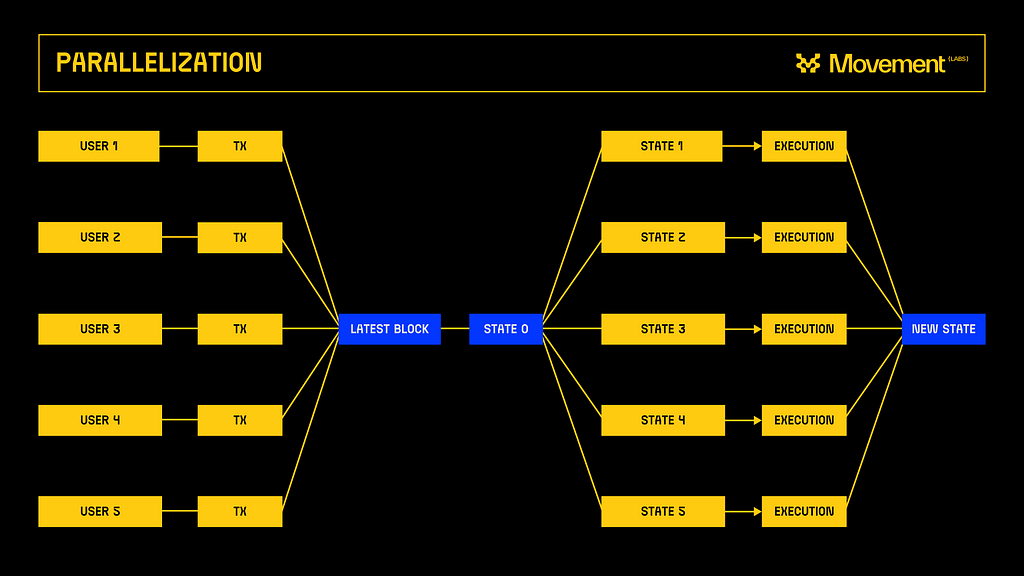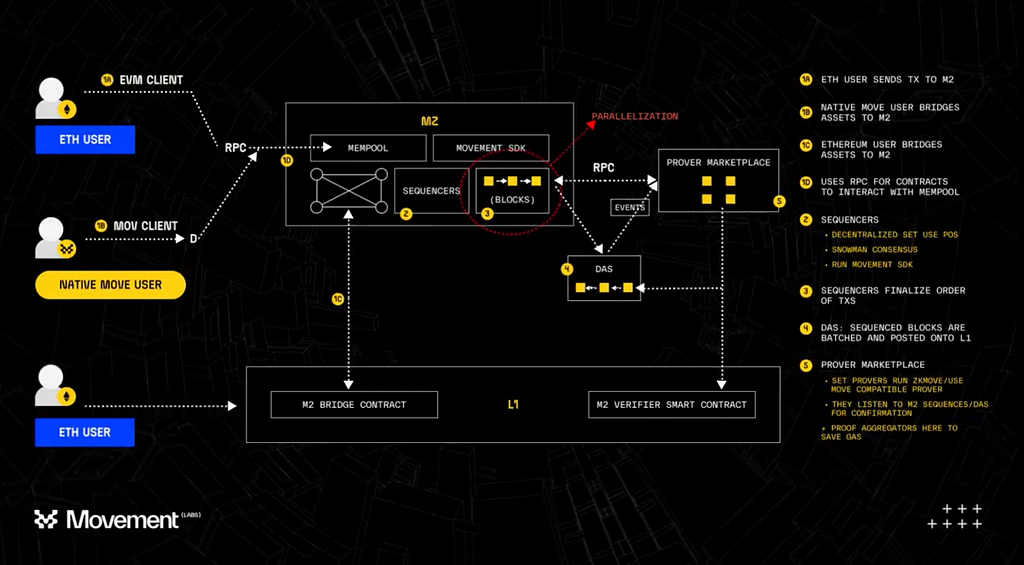Parallelization: A Fresh Perspective on Blockchain Transactions

Parallelization introduces a major step forward in blockchain technology, transitioning from conventional sequential processing to a model where transactions occur concurrently. This shift is akin to transforming a congested single-lane road into a multi-lane expressway, where transactions, much like vehicles, move alongside each other seamlessly. Leveraging the power of modern multi-core processors, parallelization drastically reduces transaction wait times and enhances the network’s energy efficiency. At the heart of this approach is the fundamental transformation of blockchain networks, making them more scalable and efficient by allowing multiple transactions to be processed simultaneously. This not only overcomes the longstanding issues of delays and elevated transaction fees but also heralds a new age for blockchain applications, characterized by improved scalability and enhanced network performance.
The Downside of Sequential Processing
The sequential processing model, foundational to many blockchain networks such as Ethereum, faces significant challenges as the demand and complexity of transactions grow. This approach, which processes transactions in the order they are received, has become a bottleneck, impacting the network’s efficiency and scalability.
Below, we outline the key drawbacks of sequential processing before exploring each in detail:
- Limited System Throughput: Impedes the network’s ability to handle escalating activity.
- Increased Congestion and Delays: Leads to network congestion, causing significant transaction delays.
- Rising Transaction Fees: Triggers a competitive bidding for transaction prioritization, inflating gas fees.
- Scalability Constraints: Exacerbates scalability issues during peak transaction periods.
Sequential processing’s linear nature, though effective in maintaining transaction integrity and network consensus, severely restricts system throughput as blockchain usage intensifies. The advent of decentralized finance (DeFi) applications, non-fungible tokens (NFTs), and complex smart contracts has introduced a volume and variety of transactions that the original model is ill-equipped to manage efficiently. This inadequacy results in a congested network, where transactions pile up, leading to longer wait times and diminished user experience.
The congestion inherent in sequential processing also precipitates a surge in transaction fees. Users, in an attempt to expedite their transactions, engage in a bidding war, offering higher gas fees for prioritization. This not only inflates the cost of transaction processing but also undermines the equitable access principle that blockchain technology aims to uphold.
Furthermore, the scalability of blockchain networks is critically challenged under the sequential processing model, particularly evident during peak usage times. The system’s inability to process transactions swiftly creates a bottleneck, significantly slowing down transaction validation and block creation. This scalability issue not only hampers the network’s performance but also limits its potential for broader adoption and innovation, highlighting the urgent need for alternative processing methods to accommodate blockchain technology’s evolving landscape.
Sequential Processing: The Bottleneck
The bottleneck effect of sequential processing on blockchain networks is analogous to a single-lane road overwhelmed by traffic, where the capacity to accommodate transactions efficiently is outstripped by demand. This model places a hard limit on the network’s throughput, dictating that transactions can only be processed as fast as the slowest link in the chain allows. In the context of Ethereum, this not only means delayed transactions but also fluctuating, often exorbitant, transaction fees as users vie for their transactions to be processed in the next block. Such a system is inherently inequitable and unsustainable, particularly as blockchain aims to be a foundational technology for future financial systems and applications requiring real-time or near-real-time processing. The repercussions extend beyond user dissatisfaction, hindering the broader adoption of blockchain for high-volume, transaction-intensive applications. The sequential processing model, while foundational to ensuring the security and integrity of blockchain transactions, presents a clear and present challenge to the technology’s evolution, calling for innovative solutions to transcend these limitations and unlock blockchain’s full potential.
Overcoming Blockchain’s Sequential Hurdles: The Path to Efficiency and Scalability
The underlying technical architecture of many blockchain networks, especially those following Ethereum’s model, reveals a significant underutilization of the computational resources available in contemporary hardware. Modern processors, equipped with multiple cores capable of executing several threads in parallel, sit largely idle in the conventional blockchain transaction processing setup. This is because the current paradigm, designed around sequential execution, does not capitalize on the parallel processing capabilities inherent in these powerful multi-core environments. Consequently, there’s a substantial inefficiency in energy use and computational power, with a considerable portion of the available processing capacity remaining untapped. This inefficiency is not just a matter of wasted electricity but also represents a missed opportunity to enhance transaction throughput and network responsiveness significantly.
Furthermore, the Ethereum Virtual Machine (EVM) mempools, the holding areas for transactions awaiting confirmation, introduce additional technical challenges. These mempools can become bottlenecks themselves, especially during times of high network activity. Transactions accumulate, waiting for miners to pick them up for processing, which can lead to unpredictable delays and increased susceptibility to manipulation, such as prioritizing transactions through higher fees. This congestion within the EVM mempools not only exacerbates the inefficiencies related to sequential processing but also highlights the system’s vulnerability to security risks, as attackers might exploit the mempool’s dynamics to their advantage. The congestion and manipulation issues within EVM mempools underscore a critical area for improvement, pressing the need for more robust and efficient transaction processing mechanisms that can better leverage the hardware’s capabilities and ensure a more secure and equitable network operation.
Parallel Execution: The Road to Efficiency
The transition to parallel execution heralds a transformative phase in blockchain technology, marking a departure from the traditional sequential processing to a more dynamic, distributed model. This innovative approach entails the allocation of transactions across multiple nodes within the network, allowing for their simultaneous processing. Such a methodology not only enhances the transaction throughput by eliminating bottlenecks inherent in the sequential model but also upholds the blockchain’s core principles of integrity and security. By enabling a more efficient transaction flow, parallel execution addresses the scalability issues that have long plagued blockchain networks, offering a scalable solution that can adapt to increasing demand without compromising on performance or security.
Unpacking Parallel Execution: A Deeper Dive into Concurrent Blockchain Processing
Parallel execution fundamentally transforms the blockchain landscape by introducing a mechanism where transactions are processed simultaneously, rather than in a linear sequence. This shift mirrors the efficiency found in multi-lane highways, allowing for a greater volume of transactions to be processed at the same time, effectively cutting down on wait times and boosting the network’s capacity. At the core of this approach are advanced algorithms designed to orchestrate the simultaneous processing of transactions across various nodes within the blockchain network. This orchestration is critical to maintaining the coherence and reliability of the blockchain, ensuring that the parallel processing of transactions does not compromise the network’s integrity.
The process of parallel execution involves complex protocols for identifying and managing dependencies between transactions, as well as resolving any potential conflicts that may arise from attempting to process transactions concurrently. These protocols are essential for maintaining the blockchain’s consistent state, preventing issues such as double-spending or transaction reversal. By implementing such mechanisms, parallel execution marks a significant shift towards creating blockchain networks that are not only more resilient and efficient but also capable of scaling to meet the demands of an increasing number of applications.
Delving into the specifics, platforms like Sui and Aptos have pioneered distinct methods of implementing parallel execution, each tailored to optimize their network’s performance and scalability. Sui, for instance, adopts an object-centric approach to parallelism. In this model, the blockchain’s state is segmented into discrete objects that can be operated on independently and in parallel. This significantly minimizes transaction contention, as operations on separate objects do not overlap or interfere with one another. Such an architecture not only accelerates transaction processing times but also enhances the network’s capacity to manage a larger volume of transactions simultaneously. Sui’s object-centric parallelism exemplifies how targeted, parallel processing strategies can markedly improve blockchain efficiency and throughput without sacrificing security or data integrity.
Similarly, Aptos introduces a revolutionary consensus mechanism alongside its parallel execution engine, Block-STM (Software Transactional Memory), to facilitate concurrent transaction execution while maintaining the ACID properties crucial for database transactions. Aptos’s approach strategically sequences transactions within a block, executing them in parallel and efficiently resolving any arising conflicts or dependencies in real time. This dynamic transaction ordering and execution mechanism leverages computational resources more effectively, significantly boosting the network’s throughput. Both Sui and Aptos illustrate the evolving landscape of blockchain technology, where innovative parallel execution models pave the way for more scalable, efficient, and robust blockchain networks. These advancements not only address the limitations of sequential processing but also open up new avenues for blockchain application development and deployment, heralding a future where blockchain’s potential is fully realized.
The Future Is Parallel: Pioneering a New Blockchain Epoch
The advent of parallel execution and the development of platforms like MoveVM are at the forefront of ushering in a new era of blockchain technology. This shift towards parallelization addresses the pressing challenges of transaction speed, network scalability, and energy consumption, paving the way for a more versatile and sustainable blockchain ecosystem. Parallelization is not merely a technical upgrade; it embodies a strategic reimagining of blockchain’s infrastructure to accommodate the growing demands of diverse applications, from financial transactions and smart contracts to decentralized applications (DApps) and beyond.
Parallel execution, particularly as enabled by innovative solutions like MoveVM, represents a pivotal leap in blockchain’s evolution. By dismantling the barriers to scalability and efficiency, parallelization opens the door to a plethora of opportunities for blockchain’s integration into various sectors, heralding a future where blockchain technology is not only more accessible and efficient but also capable of supporting a broader array of applications and services. This paradigm shift highlights the potential for blockchain to transcend its current limitations, promising a future where the technology’s full capabilities are unlocked, fostering an environment ripe for innovation, growth, and widespread adoption.
The Advantages of Parallelization Across Blockchain Networks
Parallel execution significantly reshapes the blockchain landscape, offering a suite of enhancements that tackle long-standing inefficiencies and scalability issues. This advanced approach introduces several key benefits that collectively contribute to a more robust, agile, and sustainable blockchain ecosystem.
Below, we outline these benefits before diving deeper into each:
- Alleviated Network Congestion: Eases traffic bottlenecks in EVM mempools.
- Optimized Hardware Utilization: Maximizes the efficiency of multi-core processors.
- Enhanced Scalability and Speed: Accelerates transaction processing for DApps.
- Improved System Integrity: Ensures transaction harmony and prevents conflicts.
By distributing transactions across multiple nodes for simultaneous processing, parallel execution effectively mitigates congestion within Ethereum Virtual Machine (EVM) mempools, especially during peak traffic times. This approach not only streamlines the flow of transactions but also stabilizes gas fees, thereby enhancing the overall accessibility and growth potential of the network.
Furthermore, parallel execution capitalizes on the capabilities of modern multi-core processors, optimizing computational resources to reduce energy consumption and boost processing speeds. This strategic utilization of hardware not only advances the blockchain’s efficiency but also aligns with global sustainability goals, offering a greener, more energy-efficient solution.
The scalability and speed enhancements brought about by parallel execution are invaluable for decentralized applications (DApps), which previously faced limitations due to processing delays. This reduction in transaction latency enables DApps to operate more seamlessly, supporting a wider variety of applications and facilitating blockchain’s expansion to accommodate a growing user base without sacrificing performance.
Lastly, parallel execution introduces sophisticated protocols to manage and synchronize transaction processing, effectively preventing potential conflicts and ensuring the integrity of the blockchain. This meticulous orchestration of transactions maintains the network’s security and reliability, key factors as blockchain technology continues to evolve and scale. Through these advancements, parallel execution marks a pivotal step forward in overcoming the challenges of traditional blockchain models, heralding a new era of efficiency, scalability, and innovation.
Navigating Parallelization’s Challenges
While parallelization offers a promising avenue for enhancing blockchain technology, it also introduces specific challenges that must be carefully managed to realize its benefits fully. These hurdles include the potential for inconsistencies in the blockchain ledger, the complexity of coordinating concurrent transactions, and the demands on computational resources.
Below, we outline these challenges in detail:
- Potential for Ledger Inconsistencies: The simultaneous processing of transactions raises the possibility of inconsistencies, such as double-spending or changes in transaction order, threatening the blockchain’s integrity and security.
- Need for Sophisticated Coordination: Ensuring that concurrent transactions do not conflict requires advanced coordination mechanisms, underpinned by complex algorithms.
- Computational Resource Demands: The implementation of parallel processing necessitates significant computational resources, adding a layer of technical complexity that could hinder seamless adoption.
Parallelization’s approach to processing transactions concurrently, while significantly improving efficiency and scalability, risks introducing ledger inconsistencies. Such inconsistencies are problematic, potentially leading to double-spending issues or alterations in the intended transaction sequence. These challenges could undermine the trust and reliability that are foundational to blockchain’s appeal, necessitating robust solutions to maintain ledger integrity despite the increased throughput.
Moreover, the sophisticated coordination required to manage parallel transaction processing is non-trivial. It demands intricate algorithms capable of orchestrating a symphony of transactions without allowing any to clash, preserving the orderly execution of operations within the blockchain’s decentralized framework. This level of complexity not only challenges the development and implementation of parallel processing solutions but also places a premium on computational resources.
The computational demands of parallel processing, from executing complex coordination algorithms to managing the increased transaction load, pose another significant challenge. Ensuring that blockchain networks have the necessary computational power to support parallelization involves considerable investment in technology and infrastructure, potentially limiting the accessibility of this solution to only the most resource-rich networks.
In summary, while parallelization stands as a critical evolution in blockchain technology, addressing its challenges requires a careful balance of technical innovation, resource allocation, and ongoing management to preserve the blockchain’s integrity, security, and user trust.
Movement Labs’ Strategic Solutions
At Movement Labs, we’re acutely aware of these challenges and are actively developing solutions to address them head-on. Our approach revolves around enhancing the MoveVM with innovative features designed to mitigate the risks associated with parallel processing. By implementing a robust conflict resolution protocol within MoveVM, we ensure that transactions are processed in a way that maintains the chronological integrity of the blockchain. This protocol is designed to identify and resolve potential conflicts before they can affect the ledger, thus preserving the consistency and reliability of the network.
Furthermore, we’re leveraging the power of artificial intelligence and machine learning to optimize the transaction validation process. This allows MoveVM to predict potential bottlenecks and dynamically allocate resources to maintain high throughput without compromising security. Our commitment to research and development in this area signifies our dedication to overcoming the shortcomings of parallelization, ensuring that the blockchain networks powered by MoveVM are not only faster and more scalable but also secure and reliable.
By addressing these challenges, Movement Labs is paving the way for a new era of blockchain technology, where the full benefits of parallelization can be realized without the associated risks. Our efforts underscore our commitment to advancing blockchain technology and our vision for a future where blockchain’s potential is fully unleashed.
Introducing MoveVM by Movement Labs: A Leap Towards Scalability
At Movement Labs, we’ve crafted MoveVM to directly tackle the inherent challenges of parallel execution in blockchain technology, ensuring an unparalleled leap towards scalability, modularity, and interoperability within the blockchain ecosystem. Our innovative approach is meticulously designed to streamline and enhance the blockchain architecture, addressing critical areas where traditional models have faltered.

Bridging the Gap: Modularity and Interoperability
A cornerstone of MoveVM’s innovation is its foundational focus on modularity and interoperability. By enabling seamless and efficient processing of transactions across diverse blockchain platforms, MoveVM addresses one of the most pressing limitations of current blockchain ecosystems: the lack of fluid communication and operation between isolated networks. Modularity within MoveVM allows for the network to be dynamically updated or modified without disrupting the system, ensuring continuous operation and evolution. Interoperability, on the other hand, is facilitated through MoveVM’s native bridging capabilities, allowing transactions to span effortlessly across EVM and Move ecosystems, thereby maximizing throughput and efficiency.
Modularity: The Missing Piece
The integration of modularity into MoveVM by Movement Labs is a strategic enhancement crucial for optimizing parallelization within blockchain systems. This architectural innovation significantly bolsters the blockchain’s ability to manage and execute transactions concurrently, addressing a fundamental challenge in the parallel processing landscape.
By implementing a modular execution layer, MoveVM offers a revolutionary approach that enhances how blockchain infrastructures interact with various consensus layers, a necessity for effective parallelization. Traditional virtual machines (VMs) encounter numerous integration challenges, often leading to inefficiencies across critical areas such as mempools, APIs, and block processing mechanisms. These inefficiencies can severely hamper the blockchain’s capacity for parallel processing, limiting the system’s scalability and responsiveness. MoveVM’s modular design meticulously eliminates these barriers, facilitating a seamless integration of blockchain components. This ensures that each component can operate independently and in parallel, significantly increasing the system’s efficiency and capacity for handling transactions.
The modular framework of our MoveVM is particularly beneficial for parallelization as it allows for the dynamic scaling and adaptation of the blockchain network. Networks equipped with this MoveVM can easily expand or modify their processing capabilities to meet the demands of an increasing volume of transactions. This flexibility is instrumental in maintaining high throughput and reducing transaction processing times, key factors in achieving effective parallelization. Furthermore, the enhanced interoperability brought about by modularity ensures that transactions can be processed across different blockchain ecosystems without friction, further amplifying the benefits of parallel processing.
In summary, our MoveVM focus on modularity directly addresses the technical demands of parallelization, providing a robust solution that elevates blockchain technology’s scalability, efficiency, and adaptability.
MoveVM’s Interoperability Advantage
The interoperability advantage of MoveVM represents a pivotal technical breakthrough in facilitating parallelization within blockchain ecosystems. At Movement Labs, we’ve ingrained interoperability into the very fabric of MoveVM, recognizing it not just as a supplementary feature but as a core principle essential for the next evolution of blockchain technology. Through the deployment of our SDKs, equipped with native bridging capabilities, MoveVM eradicates the reliance on third-party technologies, thereby enabling a direct, seamless flow of transactions across diverse blockchain networks.
This intrinsic interoperability significantly bolsters the operational efficiency of blockchain systems, allowing them to communicate and transact with one another effortlessly. Such a capability is crucial for parallel processing, as it ensures that transactions can be distributed and processed across different ecosystems without the usual barriers. This not only speeds up transaction times but also widens the scope for application development, deployment, and integration, promoting a blockchain environment that is truly interconnected and versatile.
Moreover, by facilitating this level of interoperability, MoveVM directly contributes to enhancing the scalability of blockchain networks. It allows for a more dynamic allocation of processing tasks across chains, optimizing resource use and reducing bottlenecks that typically arise from single-chain processing limitations. Consequently, blockchain networks powered by our MoveVM are poised to become more robust, and capable of handling an increased volume and variety of transactions with improved security and reliability.
MoveVM Innovations Made Possible
MoveVM encapsulates a series of innovations designed to refine and enhance the functionality of blockchain systems. These innovations are crafted to ensure seamless transaction processing, bolster network capacity, and maintain the integrity and security of blockchain data.
Below, we detail the cornerstone features of MoveVM:
- Mempool Sync
- Block Building
- Block Committing
The Mempool Sync feature in MoveVM is engineered to revolutionize the preparation of transactions for parallel processing. Traditional mempool management often leads to congestion, significantly slowing down transaction throughput. MoveVM tackles this by optimizing the ordering and prioritization of transactions in the mempool, ensuring they are ready for efficient parallel processing. This optimization is achieved through advanced algorithms that assess transaction dependencies and urgency, aligning them in a manner that reduces processing time and prevents bottlenecks. By streamlining this initial phase, Mempool Sync greatly enhances the network’s capacity to manage and expedite transactions, setting the stage for a seamless parallel execution process.
Following the optimization of the mempool, MoveVM’s Block Building innovation leverages live transaction data to significantly speed up the assembly of blocks. This feature dynamically organizes and compiles transactions into blocks, optimizing for the quickest possible assembly based on current network conditions. The use of real-time data ensures that Block Building can adaptively respond to fluctuations in network activity, prioritizing transactions effectively to maintain high throughput. This capability not only improves the speed at which transactions are aggregated and processed but also contributes to the overall efficiency and responsiveness of the blockchain network.
Once blocks are assembled, the block-committing process in MoveVM secures and validates transactions, ensuring they are accurately recorded on the blockchain. This step is crucial for maintaining the integrity and trustworthiness of the network. Employing sophisticated cryptographic techniques and consensus algorithms, Block Committing verifies each transaction within a block, permanently engraving them into the blockchain ledger. This ensures that all transactions are immutable once confirmed, safeguarding the network against tampering and reinforcing the security of the blockchain. The Block Committing feature exemplifies MoveVM’s commitment to upholding the highest standards of data integrity and network reliability.
At Movement Labs, our MoveVM stands as a testament to significant advancements in blockchain technology. Tackling the intricate challenges of parallel processing — from transaction preparation through to block assembly and validation — MoveVM elevates blockchain networks’ scalability, efficiency, and security. This holistic approach not only streamlines transaction processing but also sets the stage for wider adoption and innovation within the blockchain ecosystem, underscoring our commitment to expanding the capabilities and reach of blockchain technology.
Conclusion: A Huge Step Forward For Blockchain Technology
As we conclude our exploration of blockchain’s evolution towards parallelization, it’s evident that this transition marks a significant milestone in our journey at Movement Labs. Our dedication to refining blockchain technology through MoveVM reflects a broader commitment to advancing the digital landscape. By championing parallel processing, we’re not just addressing current limitations but are paving the way for a future where blockchain’s capabilities are fully realized. Our efforts underscore a vision for a blockchain ecosystem that is more scalable, efficient, and interconnected, embodying the principles of modularity and interoperability that are critical for this new era. As we move forward, it is our hope that the innovations and principles embedded in MoveVM will serve as a foundation for a digital infrastructure that is not only more accessible but also capable of fostering growth, inclusion, and collaboration across the globe.
Parallelization: A Fresh Perspective on Blockchain Transactions was originally published in Movement on Medium, where people are continuing the conversation by highlighting and responding to this story.

